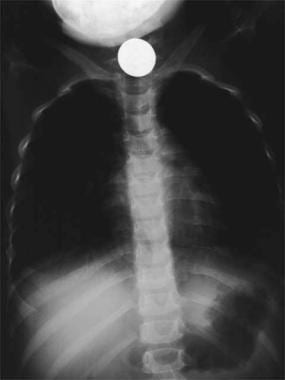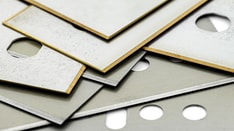Practice Essentials
As children explore and interact with the world, they will inevitably put foreign bodies into their mouths and swallow some of them.
Most swallowed foreign bodies pass harmlessly through the gastrointestinal (GI) tract. Foreign bodies that damage the GI tract, become lodged, or have associated toxicity must be identified and removed. Children with preexisting GI abnormalities (eg, tracheoesophageal fistula, stenosing lesions, previous GI surgery) are at an increased risk for complications.
Although adults most often present to the ED because of health problems related to ingestion of radiolucent foreign bodies (typically food), children usually swallow radiopaque objects, such as coins, pins, screws, button batteries, or toy parts. Although children commonly aspirate food items, it is less common for small children to present because of foreign body complications due to food ingestion. Swallowed objects are shown in the images below.
 A swallowed radiolucent object (plastic guitar pick) is made visible in the upper esophagus after ingestion of barium. Image courtesy of Raymond K. Tan, MD, and Gregory Conners, MD, MPH.
A swallowed radiolucent object (plastic guitar pick) is made visible in the upper esophagus after ingestion of barium. Image courtesy of Raymond K. Tan, MD, and Gregory Conners, MD, MPH.
Pathophysiology
Esophagus
Most complications of pediatric foreign body ingestion are due to esophageal impaction, usually at one of three typical locations. [1] The most common site of esophageal impaction is at the thoracic inlet. Defined as the area between the clavicles on chest radiograph, this is the site of anatomical change from the skeletal muscle to the smooth muscle of the esophagus. The cricopharyngeus sling at C6 is also at this level and may "catch" a foreign body. About 70% of blunt foreign bodies that lodge in the esophagus do so at this location. Another 15% become lodged at the mid esophagus, in the region where the aortic arch and carina overlap the esophagus on chest radiograph. The remaining 15% become lodged at the lower esophageal sphincter (LES) at the gastroesophageal junction.
Children with preexisting esophageal abnormalities (eg, repair of a tracheoesophageal fistula) are likely to have foreign body impaction at the site of the abnormality. If a child with no known esophageal pathology has a blunt foreign body lodged at a location other than the 3 typical locations described above, the possibility of a previously unknown esophageal abnormality should be considered. The presence of eosinophilic esophagitis has been recognized as contributing to adult esophageal foreign body impaction and may be its presenting feature; although less common in children, eosinophilic esophagitis has also been associated with pediatric esophageal food impaction. [2]
Pointed objects, such as thumbtacks, may become impaled and, therefore, lodged anywhere in the esophagus. Small objects, such as pills and smaller button batteries, may adhere to the slightly moist esophageal mucosa at any point.
Stomach/lower gastrointestinal tract
Once a swallowed foreign body reaches the stomach of a child with a normal GI tract, it is much less likely to lead to complications. Foreign bodies occasionally become lodged at the ileocecal valve. [3] Coins made largely from zinc, most notable United States cents, have been reported to interact with stomach acid leading to stomach ulceration. [4] Foreign-body — induced appendicitis has been reported. [5] Other exceptions include pointed or toxic foreign bodies or objects too long (ie, >6 cm) or too wide (ie, >2 cm) to pass through the pyloric sphincter.
Another important exception is the child who has swallowed more than one magnet; reports exist of swallowed toy magnets attracting and adhering tightly to each other through the GI tract, leading to small bowel obstruction or necrosis of intervening tissues, sometimes with severe sequelae. [6, 7, 8] Magnets may also attract other ferrous swallowed foreign bodies, causing similar problems. [9]
Children with known GI tract abnormalities are more likely to encounter complications. Previous surgery may cause abnormalities of peristalsis, increasing the likelihood of foreign body impaction. For example, children who have had surgery to correct pyloric stenosis are more likely to retain a foreign body in the stomach.
Previously unsuspected lower GI tract abnormalities may present as a complication of foreign body ingestion. For example, a small foreign body may become lodged in a Meckel diverticulum.
Impacted foreign bodies
A foreign body lodged in the GI tract may have little or no effect; cause local inflammation leading to pain, bleeding, scarring, and obstruction; or erode through the GI tract. Migration from the esophagus most often leads to mediastinitis but may involve the lower respiratory tract or aorta and create an aortoenteric fistula. Migration through the lower GI tract may cause peritonitis.
Etiology
Most cases occur as children discover and place small objects in their mouths.
Foreign body ingestion, especially if a repeated problem, may suggest a chaotic home environment and neglect.
Children with known GI tract abnormalities or previous complications of foreign body ingestion are more likely to have complications.
Older children may be seeking attention or be manifesting psychological abnormalities.
Ingestion of unusual foreign bodies may suggest an underlying abnormality. For example, an association exists between toothbrush ingestions and bulimia in teenaged girls. [10]
Epidemiology
United States statistics
Although exact figures are unavailable, foreign body ingestion is clearly common among children. More than 125,000 ingestions of foreign bodies by people aged 19 years and younger were reported to American Poison Control Centers in 2007. [11] In a cross-sectional survey of parents of more than 1500 children, 4% of the children had swallowed a coin (the most commonly swallowed foreign body in many studies). [12]
A study that analyzed emergency department (ED) visits involving magnet ingestion in children from 2002 to 2011 found that there has been an alarming increase in ED visits for magnet ingestion in children. A national estimate of 16,386 children presented to EDs in the United States during the 10-year study period with possible magnet ingestion. ED visits due to possible magnet ingestion increased 8.5-fold from 2002 to 2011 with a 75% average annual increase per year. The majority of patients reported to have ingested magnets were younger than 5 years (54.7%). [13]
International statistics
Pediatric foreign body ingestion is a worldwide problem. Impaction of swallowed fish bones is more commonly observed in countries where fish is a major dietary staple, including Asian countries. [14] A massive database describing pediatric foreign body injury in European and other countries, the "Susy Safe project," recently published information regarding nearly 17,000 cases in children aged 14 years and younger; about 18% of these involved foreign body ingestion. [15]
Sex- and age-related demographics
The male-to-female ratio in young children is 1:1. In older children and adolescents, males are more commonly affected than females.
Children of all ages ingest foreign bodies. However, incidence is greatest in children aged 6 months to 4 years. This reflects the tendency of small children to use their mouths in the exploration of their world. Younger children may be "fed" foreign bodies by older children or be intentionally given foreign bodies by abusive adults. In the teenaged years, concomitant psychiatric problems, mental disturbances, and risk-taking behaviors may lead to foreign body ingestion.
Up to 80% of all cases of esophageal foreign bodies occur in children aged 6 months to 3 years. The most common site is the cricopharynx. [16]
Prognosis
Morbidity/mortality
Most foreign bodies pass harmlessly through the GI tract and are eliminated in the stool.
Systemic reactions, such as from nickel allergy, are unusual but have been reported, typically in massive ingestions or occupational exposures.
Retained foreign bodies may cause GI mucosal erosion, abrasion, local scarring, or perforation. Complications include the following:
-
Esophageal foreign body migration may lead to peritonitis, mediastinitis, pneumothorax, pneumomediastinum, pneumonia, or other respiratory disease.
-
Migration into the aorta may produce an aortoenteric fistula, a horrific complication with a high mortality rate.
-
Esophageal button batteries may cause substantial mucosal injury in as few as 2 hours. [17]
-
Swallowed magnets in the intestines may strongly attract other swallowed magnets or metallic objects through mucosal tissues, leading to ulceration, pressure necrosis, fistula creation, or perforation. [6, 7, 8] A swallowed combination of magnets and button batteries may be especially dangerous. [9]
Complications of removal procedures may lead to iatrogenic morbidity or mortality from the procedure or from accompanying sedation/anesthesia.
Traumatic epiglottitis has been reported in conjunction with foreign body ingestion, due to epiglottis injury from a finger sweep or from the swallowed object itself, even after the object has been removed or expelled. [18]
Complications
Esophageal foreign bodies complications include the following:
-
Mucosal abrasion
-
Esophageal stricture/obstruction
-
Retropharyngeal abscess
-
Failure to thrive
-
Esophageal perforation may lead to mediastinitis, pneumothorax, pneumomediastinum, aortoesophageal fistula formation (and resulting hemorrhage), and tracheal compression.
Stomach/lower GI tract foreign body complications include the following:
-
Mucosal abrasion
-
Intestinal obstruction
Intestinal perforation may lead to peritonitis and sepsis.
Button (disk) batteries
Data suggest that ingestion of button batteries has become an increasingly important cause of morbidity and mortality in children, likely because of button batteries' increased availability and the increased production of electrical current in modern lithium batteries of ≥20 mm diameter. [19] Children 4 years or younger who have swallowed lithium batteries ≥20 mm diameter are at greatest risk of complication. [17] A study by Lee et al that included 5 cases of pediatric lithium battery ingestion, found that all cases had moderate to major complications to their esophagus or gastric mucosa, even in children who did not exhibit symptoms post ingestion. Urgent removal within 24 hours is recommended for even the asymptomatic child with a known lithium battery ingestion. [20]
-
A swallowed coin lodged at the thoracic inlet. Image courtesy of Gregory Conners, MD, MPH.
-
A swallowed radiolucent object (plastic guitar pick) is made visible in the upper esophagus after ingestion of barium. Image courtesy of Raymond K. Tan, MD, and Gregory Conners, MD, MPH.
-
Lateral radiograph demonstrating the distinctive two-step profile of a button (disk) battery in the esophagus.
-
Frontal view of same esophageal button (disk) battery; note distinctive double-circle appearance, useful to differentiate a button battery from a coin.






